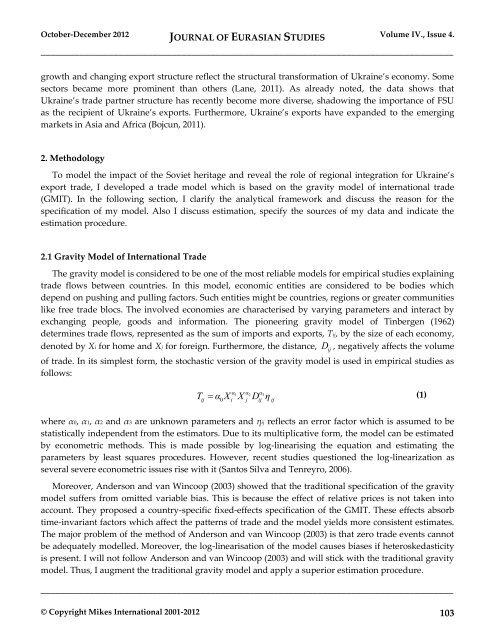You also want an ePaper? Increase the reach of your titles
YUMPU automatically turns print PDFs into web optimized ePapers that Google loves.
October-December 2012 JOURNAL OF EURASIAN STUDIES Volume IV., Issue 4.<br />
_____________________________________________________________________________________<br />
growth and changing export structure reflect the structural transformation <strong>of</strong> Ukraine’s economy. Some<br />
sectors became more prominent than others (Lane, 2011). As already noted, the data shows that<br />
Ukraine’s trade partner structure has recently become more diverse, shadowing the importance <strong>of</strong> FSU<br />
as the recipient <strong>of</strong> Ukraine’s exports. Furthermore, Ukraine’s exports have expanded to the emerging<br />
markets in Asia and Africa (Bojcun, 2011).<br />
2. Methodology<br />
To model the impact <strong>of</strong> the Soviet heritage and reveal the role <strong>of</strong> regional integration for Ukraine’s<br />
export trade, I developed a trade model which is based on the gravity model <strong>of</strong> international trade<br />
(GMIT). In the following section, I clarify the analytical framework and discuss the reason for the<br />
specification <strong>of</strong> my model. Also I discuss estimation, specify the sources <strong>of</strong> my data and indicate the<br />
estimation procedure.<br />
2.1 Gravity Model <strong>of</strong> International Trade<br />
The gravity model is considered to be one <strong>of</strong> the most reliable models for empirical studies explaining<br />
trade flows between countries. In this model, economic entities are considered to be bodies which<br />
depend on pushing and pulling factors. Such entities might be countries, regions or greater communities<br />
like free trade blocs. The involved economies are characterised by varying parameters and interact by<br />
exchanging people, goods and information. The pioneering gravity model <strong>of</strong> Tinbergen (1962)<br />
determines trade flows, represented as the sum <strong>of</strong> imports and exports, Tij, by the size <strong>of</strong> each economy,<br />
denoted by Xi for home and Xj for foreign. Furthermore, the distance, D ij , negatively affects the volume<br />
<strong>of</strong> trade. In its simplest form, the stochastic version <strong>of</strong> the gravity model is used in empirical studies as<br />
follows:<br />
α1 α2<br />
α3<br />
T α X X D η<br />
(1)<br />
ij 0 i j ij ij<br />
where α0, α1, α2 and α3 are unknown parameters and ηij reflects an error factor which is assumed to be<br />
statistically independent from the estimators. Due to its multiplicative form, the model can be estimated<br />
by econometric methods. This is made possible by log-linearising the equation and estimating the<br />
parameters by least squares procedures. However, recent studies questioned the log-linearization as<br />
several severe econometric issues rise with it (Santos Silva and Tenreyro, 2006).<br />
Moreover, Anderson and van Wincoop (2003) showed that the traditional specification <strong>of</strong> the gravity<br />
model suffers from omitted variable bias. This is because the effect <strong>of</strong> relative prices is not taken into<br />
account. They proposed a country-specific fixed-effects specification <strong>of</strong> the GMIT. These effects absorb<br />
time-invariant factors which affect the patterns <strong>of</strong> trade and the model yields more consistent estimates.<br />
The major problem <strong>of</strong> the method <strong>of</strong> Anderson and van Wincoop (2003) is that zero trade events cannot<br />
be adequately modelled. Moreover, the log-linearisation <strong>of</strong> the model causes biases if heteroskedasticity<br />
is present. I will not follow Anderson and van Wincoop (2003) and will stick with the traditional gravity<br />
model. Thus, I augment the traditional gravity model and apply a superior estimation procedure.<br />
_____________________________________________________________________________________<br />
© Copyright Mikes International 2001-2012 103

















